stop start CHEVROLET SUBURBAN 1994 Owners Manual
[x] Cancel search | Manufacturer: CHEVROLET, Model Year: 1994, Model line: SUBURBAN, Model: CHEVROLET SUBURBAN 1994Pages: 385, PDF Size: 19.88 MB
Page 66 of 385
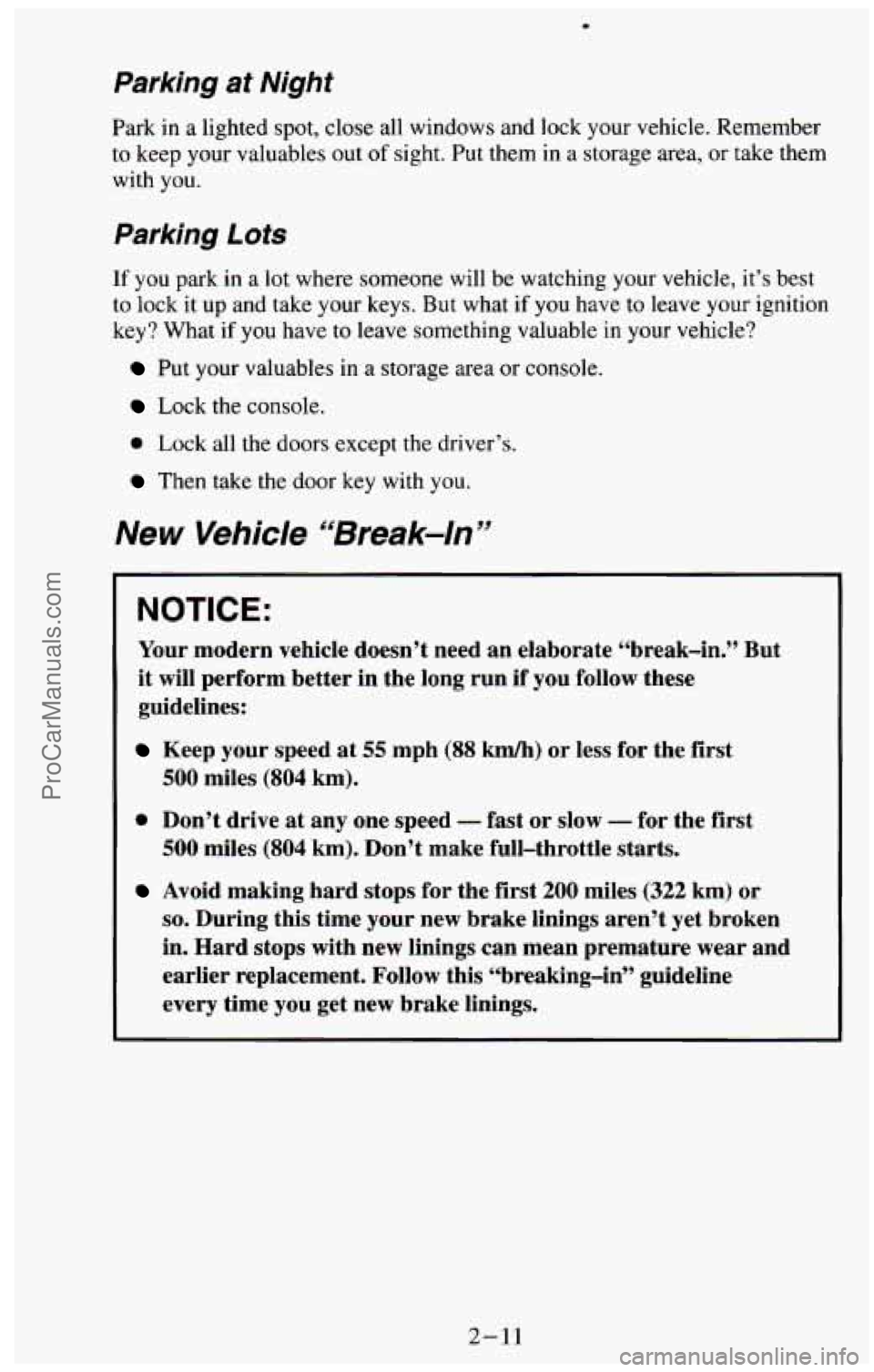
Parking at Night
Park in a lighted spot, close all windows and lock your vehicle. Remember
to keep your valuables out
of sight. Put them in a storage area, or take them
with you.
Parking Lots
If you park in a lot where someone will be watching your vehicle, it’s best
to lock it up and take your keys. But what if you have to leave your ignition
key? What if you have to leave something valuable
in your vehicle?
Put your valuables in a storage area or console.
Lock the console.
0 Lock all the doors except the driver’s.
Then take the door key with you.
New Vehicle “Break=/#”
NOTICE:
Your modern vehicle doesn’t need an elaborate “break-in.” But
it will perform better in the long run
if you follow these
guidelines:
Keep your speed at 55 mph (88 km/h) or less for the first
500 miles (804 km).
0 Don’t drive at any one speed - fast or slow - for the first
500 miles (804 km), Don’t make full-throttle starts.
Avoid making hard stops for the first 200 miles (322 km) or
so. During this time your new brake linings aren’t yet broken
in. Hard stops with new linings can mean premature wear and
earlier replacement. Follow this “breaking-in” guideline
every time
you get new brake linings,
2-11
ProCarManuals.com
Page 69 of 385
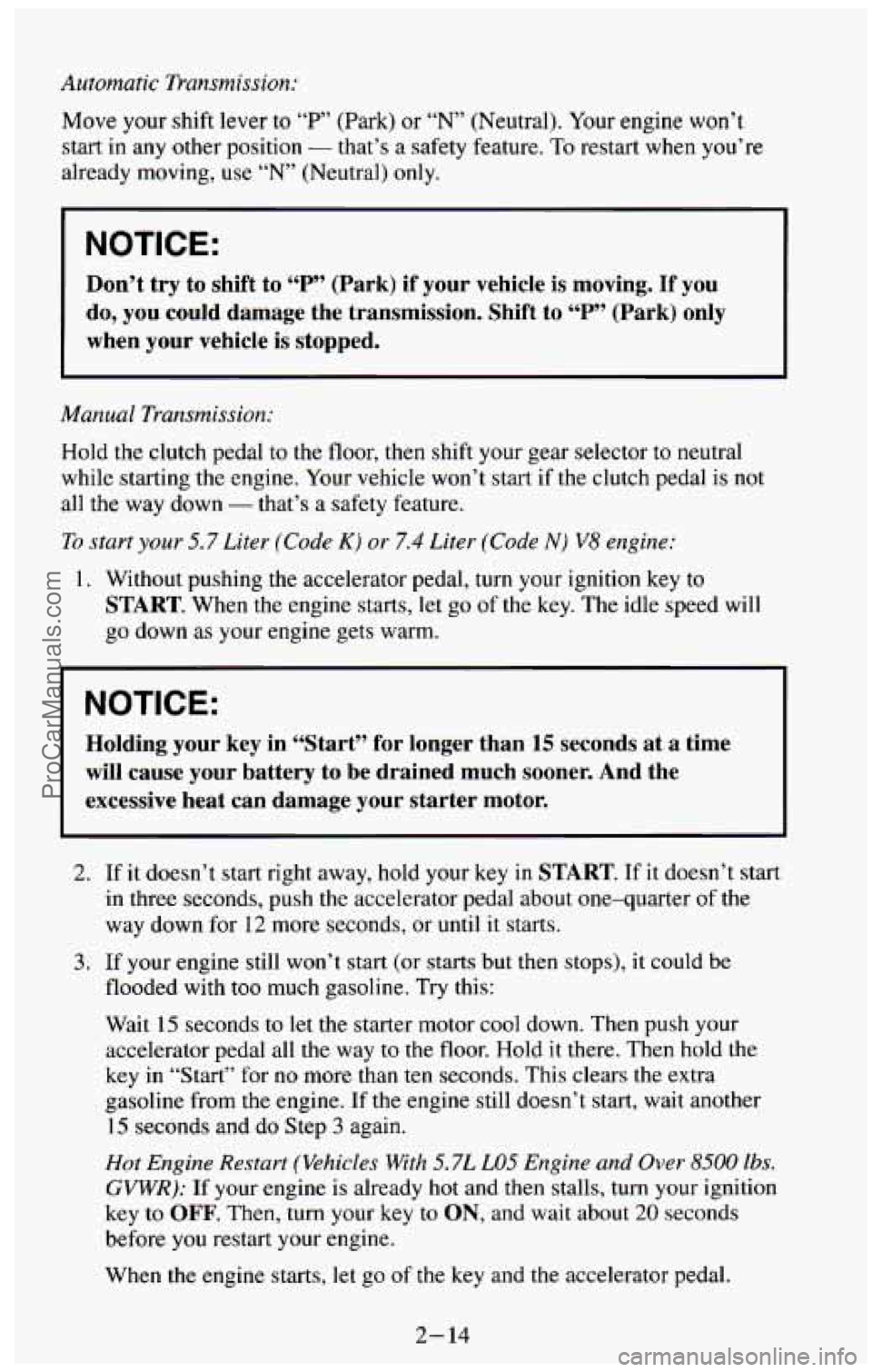
Automatic Transmission:
Move your shift lever to “P’ (Park) or “N” (Neutral). Your engine won’t
start in any other position
- that’s a safety feature. To restart when you’re
already moving, use
“N’ (Neutral) only.
NOTICE:
Don’t try to shift to “P” (Park) if your vehicle is moving. If you
do, you could damage the transmission. Shift to “P” (Park) \
only
when your vehicle is stopped.
Manual Transmission:
Hold the clutch pedal to the floor, then shift your gear selector to neutral
while starting the engine. Your vehicle won’t start if the clutch pedal is not
all the way down
- that’s a safety feature.
To start your 5.7 Liter (Code K) or 7.4 Liter (Code N) V8 engine:
1. Without pushing the accelerator pedal, turn your ignition key to
START. When the engine starts, let go of the key. The idle speed will
go down
as your engine gets warm.
NOTICE:
Holding your key in “Start” for longer than 15 seconds at a time
will cause your battery to be drained much sooner. And the
excessive heat can damage your starter motor.
2. If it doesn’t start right away, hold your key in START. If it doesn’t start
in three seconds, push
the accelerator pedal about one-quarter of the
way down for
12 more seconds, or until it starts.
flooded with too much gasoline. Try this:
3. If your engine still won’t start (or starts but then stops), it could be
Wait
15 seconds to let the starter motor cool down. Then push your
accelerator pedal all the way to
the floor. Hold it there. Then hold the
key in “Start” for
no more than ten seconds. This clears the extra
gasoline from the engine. If the engine still doesn’t start, wait another
15 seconds and do Step 3 again.
Hot Engine Restart (Vehicles With 5.7L LO5 Engine and Over 8500 lbs.
GVWR): If your engine is already hot and then stalls, turn your ignition
key to
OFF. Then, turn your key to ON, and wait about 20 seconds
before you restart your engine.
When the engine starts,
let go of the key and the accelerator pedal.
2- 14
ProCarManuals.com
Page 71 of 385
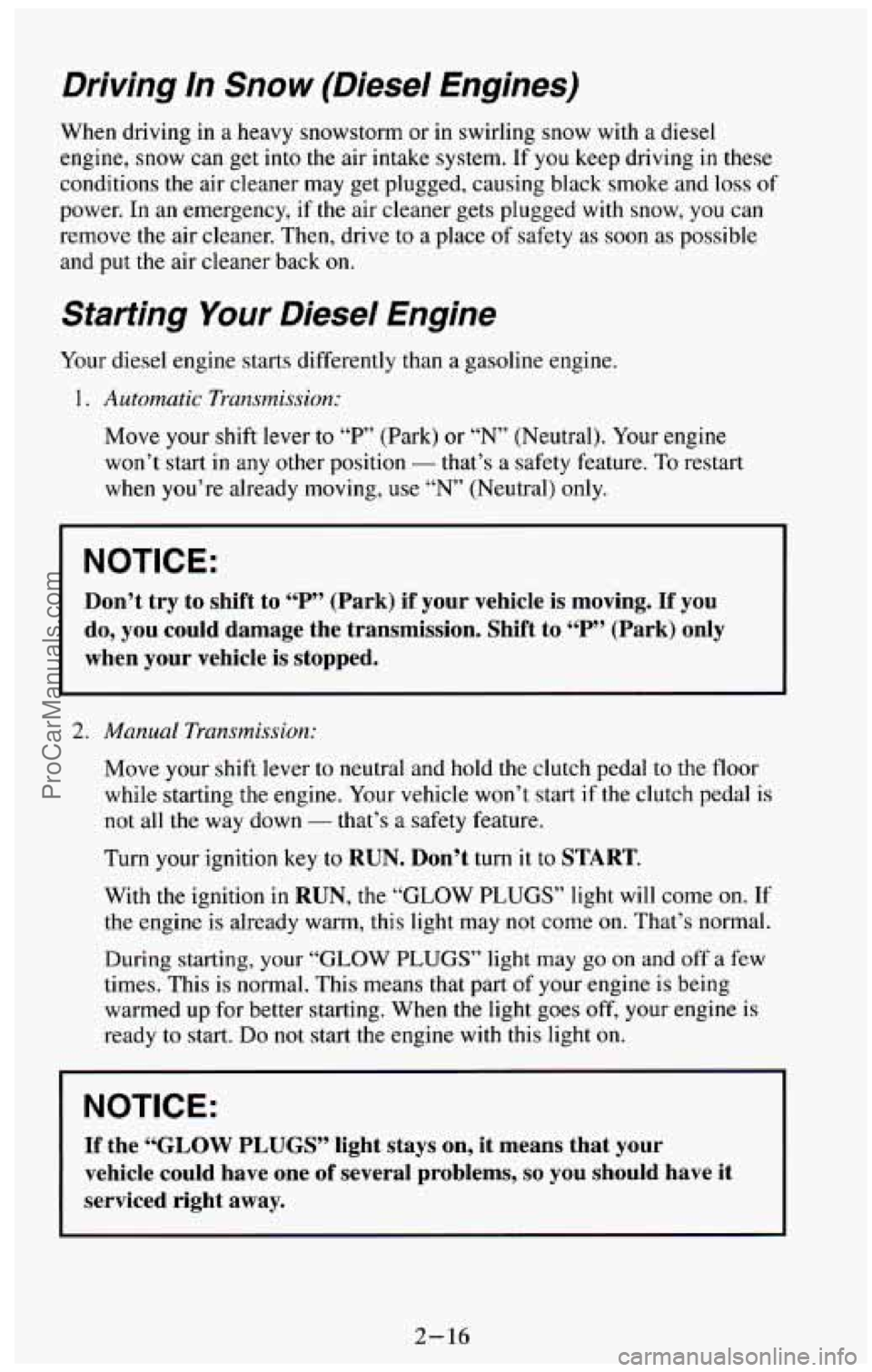
Driving In Snow (Diesel Engines)
When driving in a heavy snowstorm or in swirling snow with a diesel
engine, snow can get into
the air intake system. If you keep driving in these
conditions the air cleaner may get plugged, causing black smoke and loss of
power. In an emergency, if the air cleaner gets plugged with snow, you can
remove the air cleaner.
Then, drive to a place of safety as soon as possible
and put the air cleaner back
on.
Starting Your Diesel Engine
Your diesel engine starts differently than a gasoline engine.
1. Automatic Transmission:
Move your shift lever to “P’ (Park) or “N” (Neutral). Your engine
won’t start in any other position
- that’s a safety feature. To restart
when you’re already moving, use
“N” (Neutral) only.
NOTICE:
Don’t try to shift to 4‘P’’ (Park) if your vehicle is moving. If you
do, you could damage the transmission. Shift to
“P” (Park) only
when your vehicle is stopped.
2. Manual Transmission:
Move your shift lever to neutral and hold the clutch pedal to the floor
while starting
the engine. Your vehicle won’t start if the clutch pedal is
not all the way down - that’s a safety feature.
Turn your ignition
key to RUN. Don’t turn it to START.
With the ignition in RUN, the “GLOW PLUGS” light will come on. If
the engine is already warm, this light may
not come on. That’s normal.
During starting, your “GLOW
PLUGS” light may go on and off a few
times. This
is normal. This means that part of your engine is being
warmed up for better starting. When the light goes off, your engine is
ready to start.
Do not start the engine with this light on.
NOTICE:
If the “GLOW PLUGS” light stays on, it means that your
vehicle could have one
of several problems, so you should have it
serviced right away.
2-16
ProCarManuals.com
Page 74 of 385
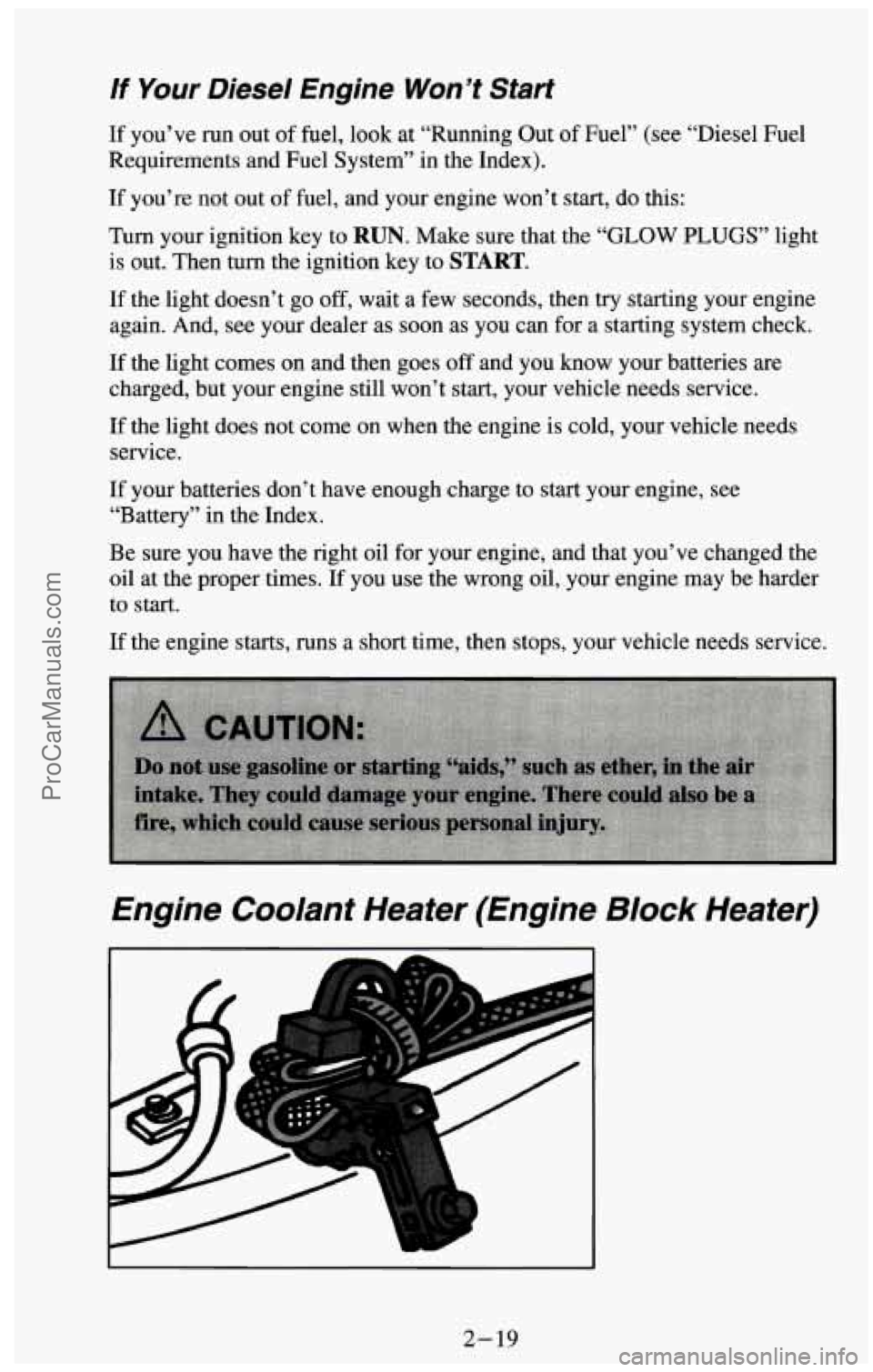
If Your Diesel Engine Won’t Start
If you’ve run out of fuel, look at “Running Out of Fuel” (see “Diesel Fuel
Requirements and Fuel System” in the Index).
If you’re not out of fuel, and your engine won’t start, do this:
Turn your ignition key to RUN. Make sure that the “GLOW PLUGS” light
is out. Then turn the ignition key to
START.
If the light doesn’t go off, wait a few seconds, then try starting your engine
again. And, see your dealer as soon as you can for a starting system check.
If the light comes on and then goes off and you know your batteries are
charged, but your engine still won’t start, your vehicle needs service.
If the light does not come
on when the engine is cold, your vehicle needs
service.
If your batteries don’t have enough charge to start your engine, see
“Battery” in the Index.
Be sure you have the right oil for your engine, and that you’ve changed the
oil at the proper times. If you use the wrong oil, your engine may be harder
to start.
If the engine starts, runs a short time, then stops, your vehicle needs service.
Engine Coolant Heater (Engine Block Heater)
2- 19
ProCarManuals.com
Page 77 of 385
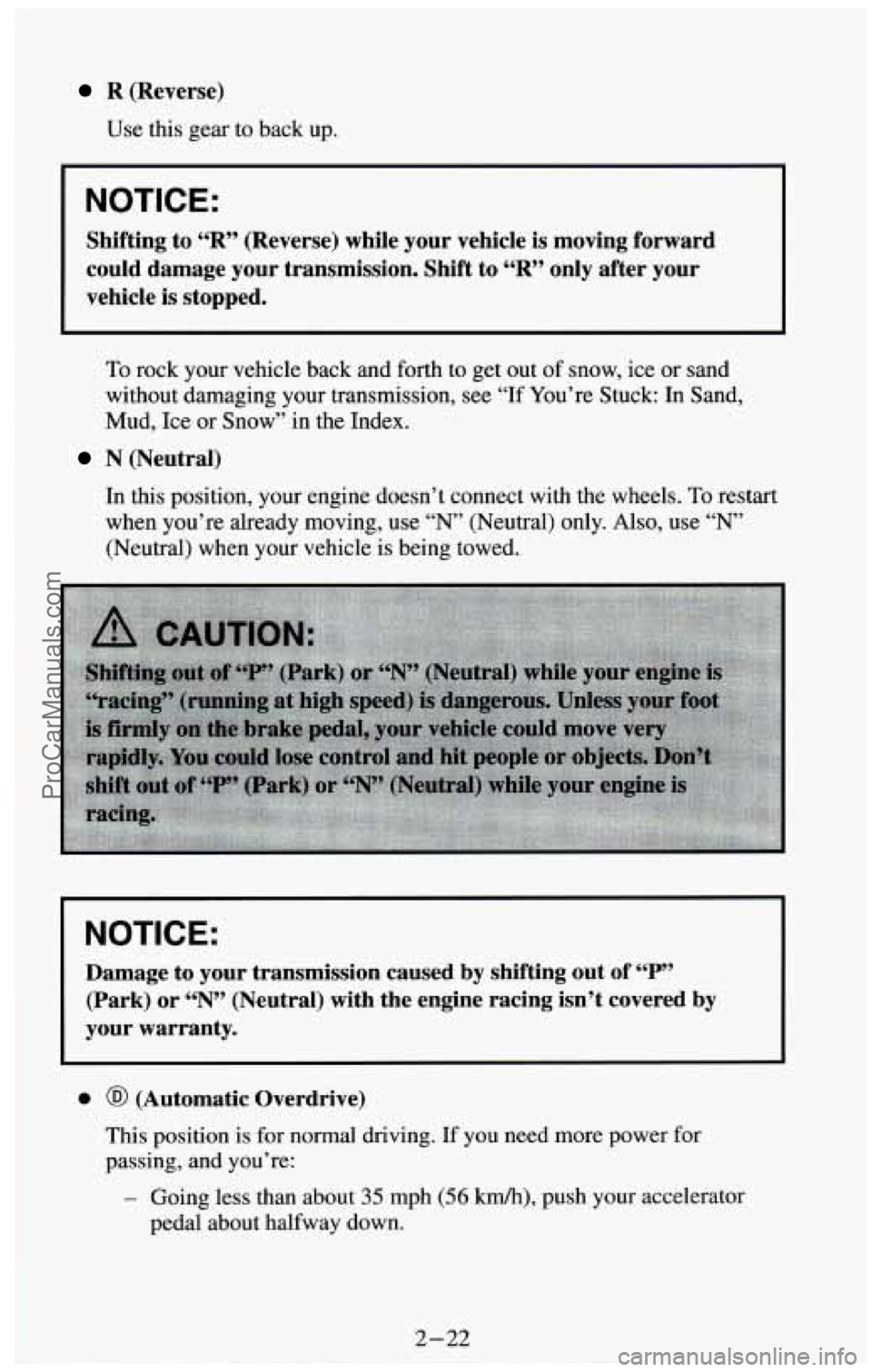
R (Reverse)
Use this gear to back up.
NOTICE:
Shifting to “R” (Reverse) while your vehicle is moving forward
could damage your transmission. Shift to
“R” only after your
vehicle is stopped.
To rock your vehicle back and forth to get out of snow, ice or sand
without damaging your transmission, see “If You’re Stuck: In Sand,
Mud, Ice or Snow’’
in the Index.
N (Neutral)
In this position, your engine doesn’t connect with the wheels. To restart
when you’re already moving, use
“N’ (Neutral) only. Also, use “N’
(Neutral) when your vehicle is being towed.
NOTICE:
Damage to your transmission caused by shifting out of “P”
(Park) or “N” (Neutral) with the engine racing isn’t covered by
your warranty.
0 @ (Automatic Overdrive)
This position is for normal driving. If you need more power for
passing, and you’re:
- Going less than about 35 mph (56 km/h), push your accelerator
pedal about halfway down.
I 2-22
ProCarManuals.com
Page 78 of 385
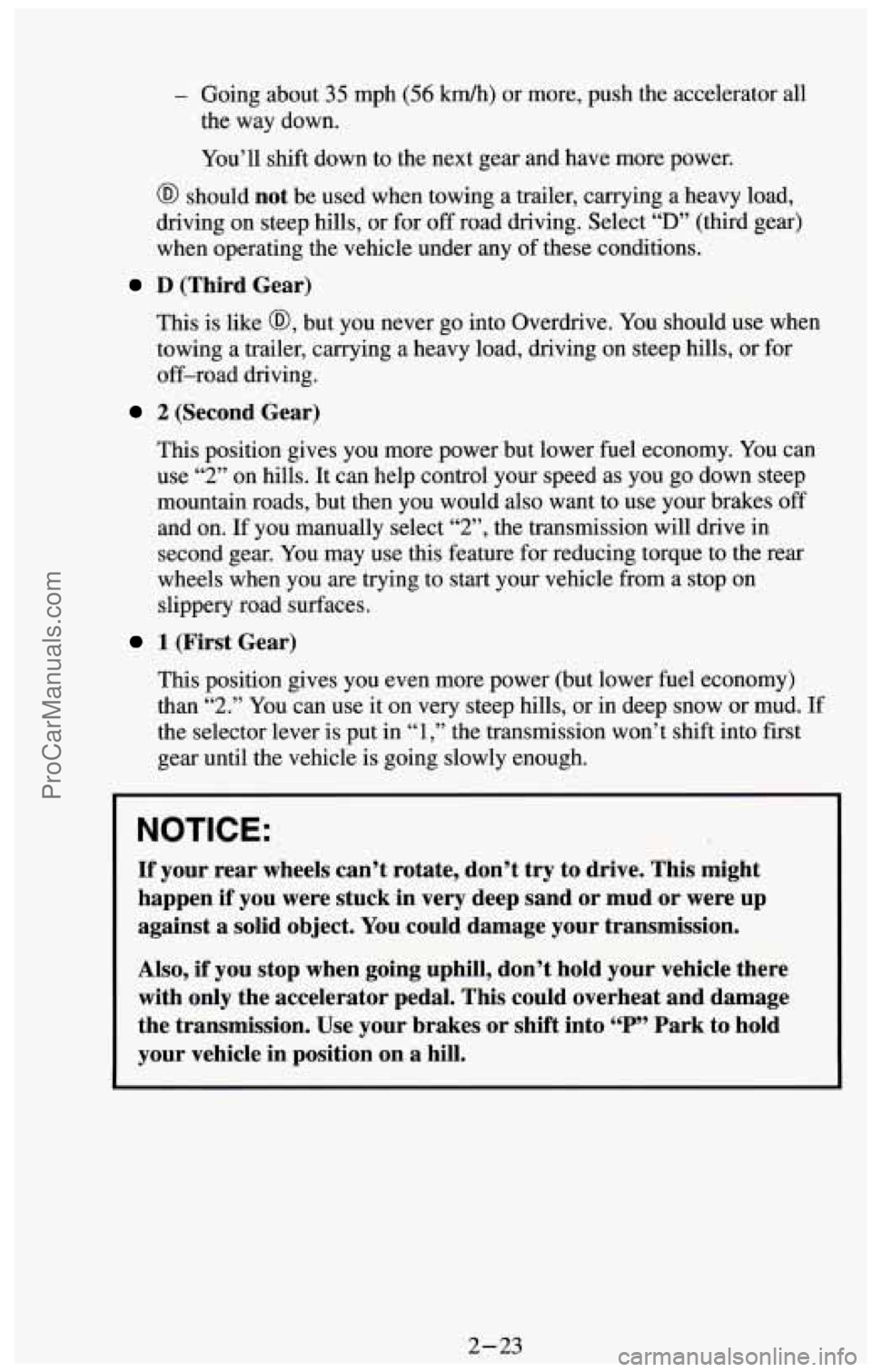
- Going about 35 mph (56 km/h) or more, push the accelerator all
the way down.
You’ll shift down to the next gear and have more power.
@ should not be used when towing a trailer, carrying a heavy load,
driving on steep hills, or for
off road driving. Select “D” (third gear)
when operating the vehicle under any of these conditions.
D (Third Gear)
This is like @, but you never go into Overdrive. You should use when
towing a trailer, carrying a heavy load, driving on steep hills, or for
off-road driving.
2 (Second Gear)
This position gives you more power but lower fuel economy. You can
use
“2” on hills. It can help control your speed as you go down steep
mountain roads, but then you would also want to use your brakes
off
and on. If you manually select “2”, the transmission will drive in
second gear.
You may use this feature for reducing torque to the rear
wheels when you are trying to start your vehicle from
a stop on
slippery road surfaces.
1 (First Gear)
This position gives you even more power (but lower fuel economy)
than
“2.” You can use it on very steep hills, or in deep snow or mud. If
the selector lever
is put in “1,” the transmission won’t shift into first
gear until the vehicle is going slowly enough.
NOTICE:
If your rear wheels can’t rotate, don’t try to drive. This might
happen if you were stuck in very deep sand or mud or were up
against
a solid object. You could damage your transmission.
Also, if you stop when going uphill, don’t hold your vehicle there
with only the accelerator pedal. This could overheat and damage
the transmission. Use your brakes
or shift into “P” Park to hold
your vehicle in position on
a hill.
2-23
ProCarManuals.com
Page 96 of 385
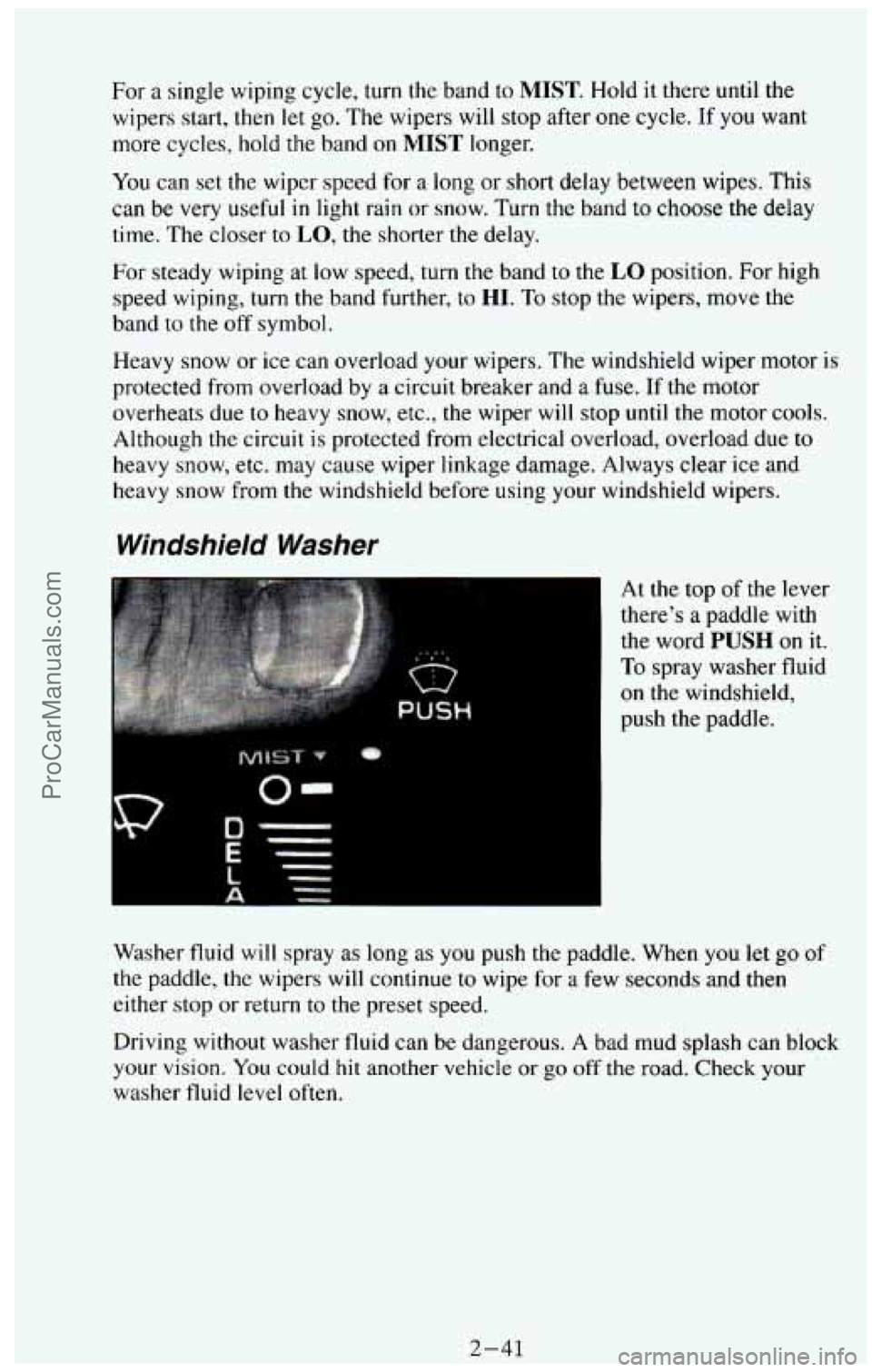
For a single wiping cycle, turn the band to MIST. Hold it there until the
wipers start, then let go.
The wipers will stop after one cycle. If you want
more cycles, hold
the band on MIST longer.
You can set the wiper speed for a long or short delay between wipes. This
can be very
useful in light rain or snow. Turn the band to choose the delay
time.
The closer to LO, the shorter the delay.
For steady wiping at low speed, turn the band to the LO position. For high
speed wiping, turn the band further, to
HI. To stop the wipers, move the
band to the off symbol.
Heavy snow or ice can overload your wipers.
The windshield wiper motor is
protected from overload by a circuit breaker and a
fuse. If the motor
overheats due to
heavy snow, etc., the wiper will stop until the motor cools.
Although
the circuit is protected from electrical overload, overload due to
heavy snow, etc. may cause wiper linkage damage. Always clear ice and
heavy snow from
the windshield before using your windshield wipers.
Windshield Washer
0-
At the top of the lever
there's
a paddle with
the word
PUSH on it.
To spray washer fluid
on the windshield,
push the paddle.
Washer fluid will spray as long
as you push the paddle. When you let go of
the paddle, the wipers will continue to wipe for a few seconds and then
either stop or return
to the preset speed.
Driving without washer fluid can be dangerous. A bad mud splash can block
your vision.
You could hit another vehicle or go off the road. Check your
washer fluid level often.
2-41 ProCarManuals.com
Page 122 of 385
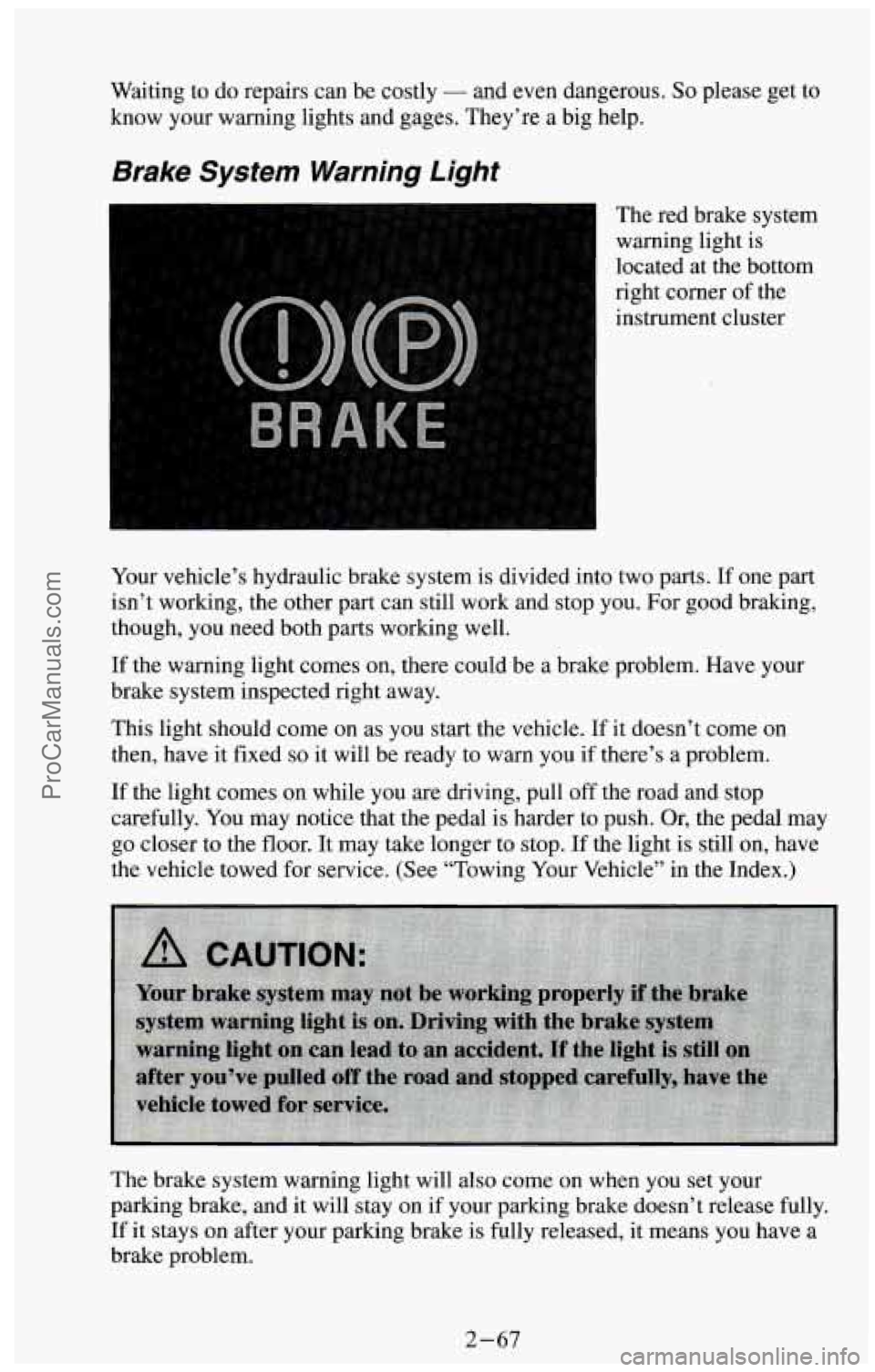
Waiting to do repairs can be costly - and even dangerous. So please get to
know your warning lights and gages. They’re a big help.
Brake System Warning Light
The red brake system
warning light is
located at the bottom
right corner of the
instrument cluster
Your vehicle’s hydraulic brake system is divided into two parts. If one part
isn’t working, the other part can still work and stop you. For
good braking,
though, you need both parts working well.
If the warning light comes on, there could be a brake problem. Have your
brake system inspected right away.
This light should come on as you start the vehicle. If it doesn’t come on
then, have it fixed
so it will be ready to warn you if there’s a problem.
If the light comes on while you are driving, pull off the road and stop
carefully. You may notice that the pedal is harder to push. Or, the pedal may
go closer to the floor. It may take longer to stop. If the light is still on, have
the vehicle towed for service. (See “Towing Your Vehicle” in the Index.)
The brake system warning light will also come on when you set your
parking brake, and it will stay on if your parking brake doesn’t release fully.
If it stays on after your parking brake is fully released, it means you have a
brake problem.
2-67
ProCarManuals.com
Page 165 of 385

Anti-Lock Brakes (ABS)
Your vehicle has an advanced electronic braking system that can help you
keep it under control. When you start your vehicle and begin to drive away,
you may hear a momentary motor or clicking noise. This is the ABS system
testing itself.
..>
Here's how anti-lock works. Let's say the road is wet. You're driving safely.
Suddenly an animal jumps out in front of you.
You slam
on the brakes. Here's what happens with ABS.
. ...
A computer senses that wheels are slowing down. If one of the wheels is
about to stop rolling, the computer will separately work the brakes at each
front wheel and at the rear wheels. The anti-lock system can change the
brake pressure faster than any driver could. The computer is programmed to
make the most
of available tire and road conditions. You can steer around
the obstacle while braking hard.
'.." *!
As you brake, your computer keeps receiving updates on wheel speed and
controls braking pressure accordingly.
4-6
ProCarManuals.com
Page 169 of 385
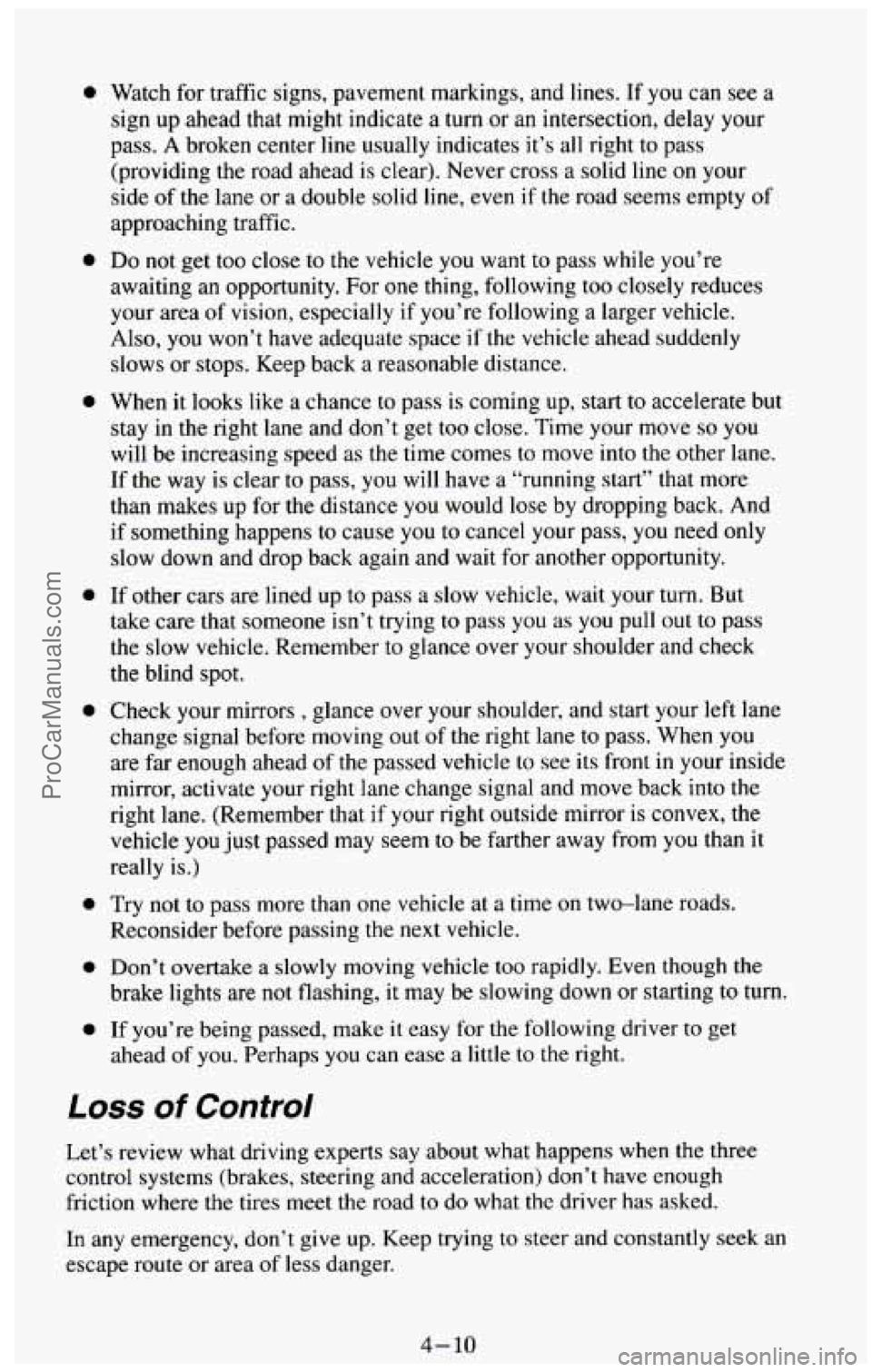
0
0
0
0
0
a
a
0
Watch for traffic signs, pavement markings, and lines. If you can see a
sign
up ahead that might indicate a turn or an intersection, delay your
pass. A broken center line usually indicates it’s all right to pass
(providing the road ahead is clear). Never cross a solid line on your
side of the lane or a double solid line, even if the road seems empty of
approaching traffic.
Do not get too close to the vehicle you want to pass while you’re
awaiting
an opportunity. For one thing, following too closely reduces
your area
of vision, especially if you’re following a larger vehicle.
Also, you won’t have adequate space if the vehicle ahead suddenly
slows or stops. Keep back a reasonable distance.
When it looks like
a chance to pass is coming up, start to accelerate but
stay in the right
lane and don’t get too close. Time your move so you
will be increasing speed as the time comes to move into the other lane.
If the way is clear to pass, you will have a “running start” that more
than makes up for the distance you would lose by dropping back. And
if something happens to cause
you to cancel your pass, you need only
slow down and drop back again and wait for another opportunity.
If other cars are lined up to pass a slow vehicle, wait your turn. But
take care that someone isn’t trying
to pass you as you pull out to pass
the slow vehicle. Remember
to glance over your shoulder and check
the blind spot.
Check your mirrors
, glance over your shoulder, and start your left lane
change signal before moving out of the right lane to pass. When
you
are far enough ahead of the passed vehicle to see its front in your inside
mirror, activate your right lane change signal and move back into the
right lane. (Remember that
if your right outside mirror is convex, the
vehicle you just passed may seem to be farther away from
you than it
really is.)
Try not
to pass more than one vehicle at a time on two-lane roads.
Reconsider before passing the next vehicle.
Don’t overtake a slowly moving
vehicle too rapidly. Even though the
brake lights are not flashing, it may be slowing down or starting to turn.
If you’re being passed, make it easy for the following driver to get
ahead
of you. Perhaps you can ease a little to the right.
Loss of Control
Let’s review what driving experts say about what happens when the three
control systems (brakes, steering and acceleration) don’t have enough
friction where the tires meet
the road to do what the driver has asked.
In any emergency, don’t give up. Keep trying to steer and constantly seek
an
escape route or area of less danger.
4-10
ProCarManuals.com